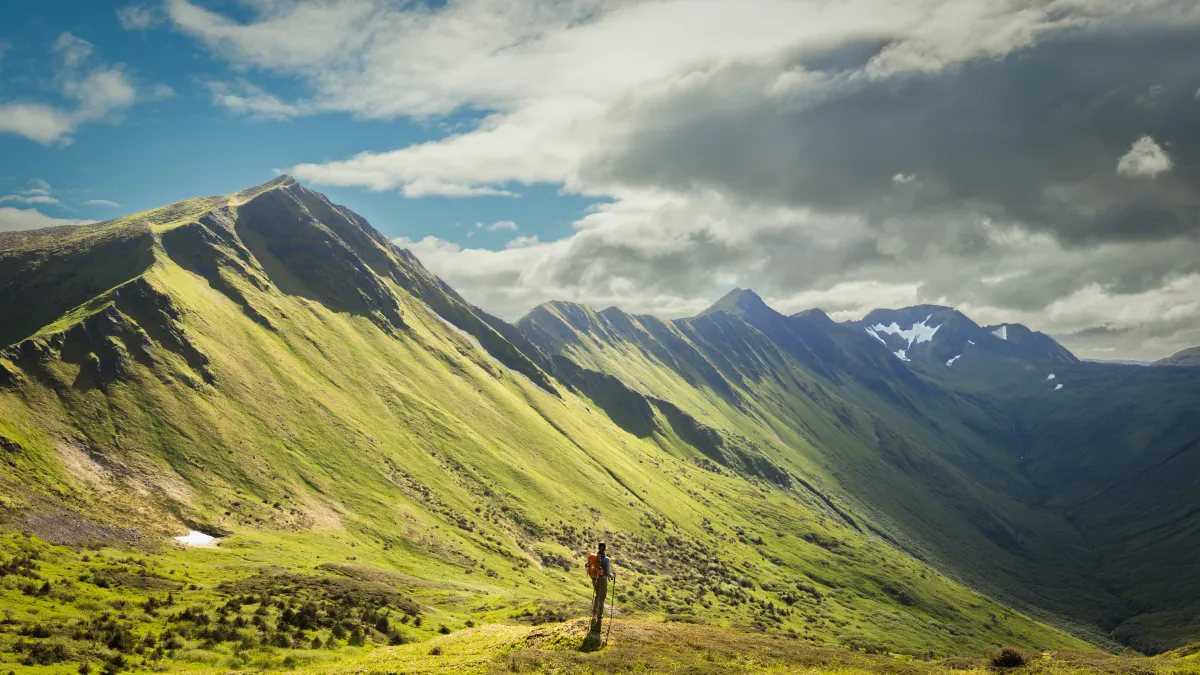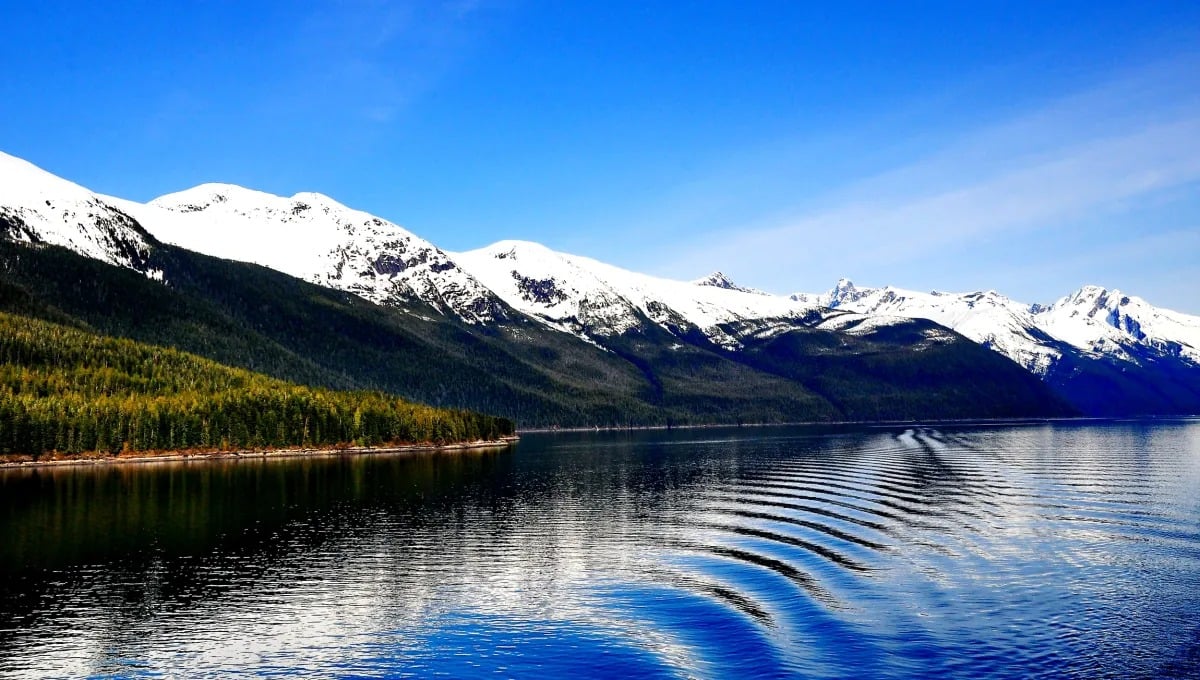
Hiking is a great way to experience all the beauty Alaska has to offer, but hiking in Alaska is a bit different than hiking elsewhere in the United States. With vast amounts of wilderness, dangerous weather conditions, and large animals, Alaska hiking requires a bit more planning and awareness then other states.
Here are some key tips to help you stay safe while you hit the trails!
1. Be Bear Aware
Alaska is home to three types of bears, brown bears (grizzlies), black bears, and polar bears. While it is unlikely that you will encounter a polar bear on your trip, brown and black bears are incredibly common throughout the state, especially during the salmon run.
To hike safely in bear country:
- Make noise while hiking, especially if you're rounding a bend or walking through dense vegetation. Talking or clapping hands periodically can alert bears to your presence.
- Carry bear spray and know how to use it. Check guidelines on traveling with bear spray if you're flying and practice deploying the spray. Only spray downwind from your location and carry your bear spray in an easily accessed spot, such as on your waist belt or straps of your backpack.
- Keep a safe distance. If you do encounter a bear, never approach it. Calmly call out to the bear to notify it of your presence. Avoid screaming, stressed sounds, or yelling, as bears do respond to tone. After you have alerted the bear to where you are, slowly back away slowly without turning your back on it. Never run from a bear, as it can trigger a chase instinct.
- Store food properly. Use bear-proof containers and avoid leaving food out in the open. If a bear does approach your area while you are eating, quickly stow your food away and keep it out of sight.
- Hike in a group of three or more people and stay together. Do not hike at dawn, dusk, or at night, as these are the times when bears can be the most active.
- Check for bear sightings by checking the trailhead info board before you depart on a trail or calling the local ranger station/state trooper office about any recent sightings. Most trails will display a yellow bear sign with information of when a bear was sighted. Do not count on this sign always being there, and always hike assuming you will encounter a bear.
2. Dress for Success
Alaska's weather is notorious for being unpredictable. To ensure you remain comfortable and safe on your hikes, be sure to pack the right gear for all conditions. These include:
- Layers. Opt for moisture-wicking base layers, a warm insulating layer, and a waterproof outer layer. Start off your hike with your clothing allowing you to stay cool, but comfortable to avoid sweating too much. By keeping your base layer dry, you will stay the most comfortable throughout the day.
- Rain gear. Even if it's sunny when you start your hike, the weather can change rapidly. Always have rain gear readily available in your pack and carry a waterproof cover to go over your backpack.
- Sturdy footwear. Choose waterproof hiking boots with good ankle support and solid grip. Alaskan trails are often very muddy and slippery, so you want an excellent pair of shoes to keep you steady.
- Sunscreen and bug spray. If you are hiking in the summer, always carry sunscreen and bug spray with you. The sun can be incredibly intense in the northern latitudes and mosquitoes can make for a very unpleasant adventure if you are not properly prepared.
3. Stay on the Trail
The Alaskan wilderness is vast, and it's easy to get lost. If you are an experienced backpacker, you may feel comfortable navigating the backcountry without a trail, however, if you are new to hiking or the area, be sure to stay on the trail at all times. In many places, you can be hundreds of miles away from the nearest town or road. Tips to remember:
- Use a map and compass. Even if you have a GPS, it's wise to carry and know how to use a map and compass as backup in case you take a wrong turn.
- Stick to marked trails. This not only ensures your safety but also helps in conserving the delicate Alaskan ecosystem. Check out the AllTrails app for downloadable trails and trail reviews.
- Carry an emergency beacon device. If you plan on doing a lot of hiking, carry an emergency beacon device (such as a Garmin Inreach) during your trip. Most of the trails in Alaska do not have cell service, so this device can help rescuers find you should you get injured or lost.
4. Be Prepared for Glacial Terrains
If you're hiking near glaciers, be aware of crevasses and rapidly changing conditions. Do not hike on glaciers without a guide or expert knowledge. Glaciers are incredibly dangerous and contain deadly crevasses that are hard to detect on the surface.
5. Inform Someone of Your Plans
Make it a habit to always let someone know where you are hiking and when you plan on returning. Have a clear plan on who they will need to contact if they cannot reach you and share your hiking route.
6. Be Prepared for River Crossings
Many trails in Alaska will cross rivers. Be prepared for your hike by carefully reviewing your route before you head out, and look for any river crossings that might occur. Be aware, rivers fed by glacier melt can rise significantly during the day and rivers close to the ocean can be impacted by tidal changes. If you have a river crossing:
- Cross in the early morning when water levels are generally lower.
- Check with a local ranger station on trail conditions and river levels. Heavy rain or snowmelt can make some rivers impassable during certain times of the year.
- Always unbuckle your backpack when crossing a river, so you can easily shed it if necessary.
- Carry trekking (hiking) poles and use your poles to help stabilize you during the crossing. River rocks can be slippery in swift currents, so trekking poles can help keep you upright.
- Do not cross deep rivers. Only cross rivers where you feel confident you can remain upright during the full crossing. If the water is moving fast and will go over your waist, consider rerouting your path or heading back.
7. Respect the Wildlife
Apart from bears, there is plenty of other Alaskan wildlife you may encounter on your hike, including moose, caribou, wolves, lynx, eagles, and more. For every wildlife encounter, remember:
- Keep a safe distance. Animals in Alaska are wild and can be unpredictable, so do not approach any wildlife, if they seem calm.
- Avoid feeding any wildlife. This is harmful to them and can lead to dangerous interactions.
- Be wary of moose. Moose are one of the most fatal animals in Alaska (not bears!). Never approach a moose and be very cautious when hiking during the rutting session (September-October) as moose can be very aggressive during this time. If you do have a negative encounter with a moose, run away and try to put something between you (such as a tree, building, or boulder). Moose typically only charge when they are approached or feel threatened, so always avoid getting close.
8. Pack Essentials
When hiking in Alaska, it is good to always have a gear bag with your essentials. This bag should include:
- Extra food and water (consider packing a water filtration system if you are hiking for numerous days)
- First aid kit with blister pads
- Sunscreen and bug spray
- Multi-tool or knife
- Headlamp or flashlight with extra batteries
- Rain gear
- Personal locator beacon or emergency beacon device
- Bear spray
- Matches and fire paste
- Map and compass
9. Be Aware of Tidal Changes
If hiking near coastal areas, be conscious of tidal changes. The Alaskan tide can change rapidly, cutting off pathways or leaving you stranded. Always consult tide tables and plan your hike around them. Remember, getting caught in a rising tide can be dangerous and potentially deadly.
- Check the tides before you hike along a beach or coastal route.
- Never hike onto the tidal flats of the Cook Inlet. These tidal flats (including the flats along the Turnagain Arm) are deposits of heavy glacier silt and can act like quick sand. People have died on the flats by becoming trapped in the dense mud and drowning in the upcoming tides. Avoid hiking out onto these flats, even if you see others out there.
10. Stay Informed
Check the weather forecast, be aware of seasonal challenges (like early snowfall or late thaws), and stay updated about any trail closures or alerts. Here are some great apps to download to help keep you informed:
- AllTrails: for trail maps, conditions, and reviews
- Windy.app: for weather and wind reports
- Gaia GPS: topography maps and satellite maps
- Alaska’s Weather Source: for weather, news alerts, earthquake alerts, and tsunami warnings
- Tides: for tide reports

